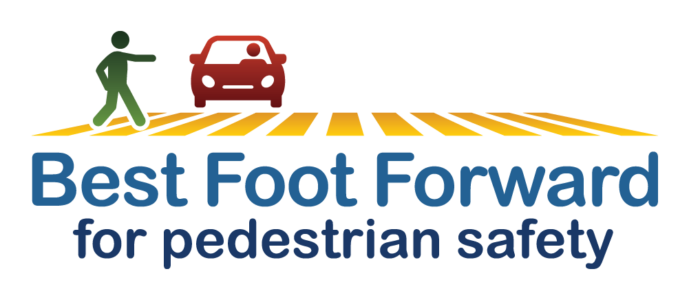In August 2024, Best Foot Forward (BFF) launched a series of sign-waving campaigns across Brevard,…

Walking As Therapy
 David Moran, 32, is the program coordinator for Bike/Walk Central Florida and the related program Best Foot Forward. An avid walker, he put his feet in motion as he grappled with the aftermath of the Pulse shootings.
David Moran, 32, is the program coordinator for Bike/Walk Central Florida and the related program Best Foot Forward. An avid walker, he put his feet in motion as he grappled with the aftermath of the Pulse shootings.
Why walk?
Walking the city – biking – being out and about – being present throughout the city – continues to help me cope. It helps me feel connected to Orlando’s on-going recovery, especially as we navigate what Mayor Dyer calls a “new normal.” By slowing down and walking, it forces me to pause – to reflect and to remember the 49, vibrant, precious lives cut short by such senseless violence. Somehow – in spite of the enormity of all this – walking – slowly but surely is helping me cope and also got me thinking more about Orlando – our big town that is on the cusp of becoming a world-class city.
For a city to be a really dynamic and inclusive, thriving place, there have to be all these options for people to get around and to be able to participate. This tragedy has just shown the importance of having many different ways of getting to places so people can be engaged with one another whether it’s under happier circumstances, such as an Orlando City soccer game, or to show our solidarity in support of the Pulse shooting victims and survivors.
Did you walk to the first memorial service at the Dr. Phillips Center in downtown Orlando?
It was about two miles from my house. I needed to walk. Walking was a meaningful way to participate and bond with friends. There’s something about walking. It’s a way of reflecting and connecting with your environment and people differently. It’s slowing down how you are participating in your community. I’m gay. I have many friends who identify as LGBTQ+ and/or Latinx. I could have been there. They could have been there. Many were there. I was numb and in shock.
It sounds like walking is a way to clear your mind, a way to organize yourself?
Yes. Walking clears my mind. When I was a kid, my Dad used to go on long walks all the time to help collect his thoughts. I would roll my eyes a lot – riding in cars was my norm then. The city I grew up in was spread out and wasn’t designed for people like my Dad in mind. So for him to walk it was really going against the whole environment and what was okay and normal. Many people still deal with this today here in Central Florida.
You live in the Mills/50 neighborhood. Does that encourage you to walk?
Absolutely. I walk to Lake Eola and people say ‘What?’ It may be little more than a mile, but it’s not far to me. Many people in Orlando find that distance to be excessive. But I love it.
Studies indicate people are willing to walk a quarter to a half mile and that’s it.
Right. I’m probably willing to walk further than most people. Convenience and comfort definitely both play a big part in this too. Walking longer distances can be a time suck. Here it can get really hot and you are going to sweat. If you don’t have shade and if you don’t have a water bottle – it can be quite intense.
Maybe those studies don’t apply to tragedies like we had in Orlando?
Through all of this tragedy, I noticed people walking and riding their bikes and getting to these places and these vigils any way they could – to grieve – to be present – to demonstrate unity in dealing with this terrible thing that’s happened.
You also had LYNX modifying its schedules and providing buses for survivors and eyewitnesses to get to the police station – also giving out free bus passes and helping transport family members and close friends of the victims and survivors to where they needed to go. And SunRail ran on evenings and the weekend so people could go downtown to the vigil at Lake Eola, where there were 50,000 people.
I often will also use Uber or Lyft when I walk or rent a Juice Bike or ride the bus. The Friday after the shooting, I was taking a Lyft ride and the driver heard me talking about the shooting with my friends. It turns out, he was driving that night and switched off his app and was taking people away from the club and to the hospital. He even took off his shirt to tie around the leg of someone who’d been shot to help stop the bleeding.




This Post Has 0 Comments